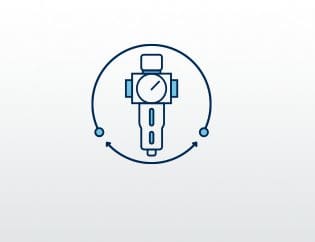Needle roller bearing characteristics and use
Characteristics and Advantages
Needle roller bearings have reduced radial dimensions and a very high load capacity relative to their size.
They can have one or two rows of rollers and, depending on the application, may be used with or without an internal ring and with or without an external ring.
In applications where it is necessary to maximize load capacity while minimizing radial space, needle roller cages are used directly. These components, consisting only of the assembly of rollers and cage, have rollers that rotate directly on tracks machined on the shaft and housing.
The internal rings of bearings with seals are 1 mm wider than the external ring to ensure that seal efficiency is maintained even when there is a slight axial displacement of the shaft with respect to the housing.
The external ring has one or more lubrication holes, allowing, depending on the application, for relubrication of the bearing through the external or internal ring.
Needle roller bearings are available in various sizes and configurations. Most of them feature flanges positioned or integrated with the external ring, while some models are also available with sliding seals.
Typical Applications
Needle roller bearings are commonly used in:
- Automatic machinery
- Textile machines
- Piston compressors
- Gardening equipment
- Internal combustion engine connecting rods
- Automotive and motorcycle transmissions
- Motorcycle suspensions
Technical Characteristics
Needle roller bearings without an internal ring provide an excellent solution when it is possible to harden and grind tracks on the shaft. Without an internal ring, the shaft can have a larger diameter, ensuring greater rigidity. Additionally, the possible axial displacement of the shaft relative to the housing is limited only by the width of the track on the shaft itself. By machining the tracks on the shaft with proper size and shape precision, it is possible to achieve a more precise rolling arrangement.
Needle roller bearings with an internal ring are used in applications where it is not possible or not cost-effective to harden and grind the shaft.
Bearings with an internal ring allow only limited axial displacement between the shaft and housing.
They are also available with sliding seals. If the standard axial displacement is insufficient, the internal rings can be replaced with larger versions.
Needle roller bearings comply with ISO 1206-1982 and ISO 15:1998 standards.
Bianchi Industrial also provides a qualified consultancy service, with specialist technicians who have the expertise to advise on the most innovative solutions, thanks to in-depth knowledge of products and the ability to assess all types of applications.
In addition to the before and after-sales service, when you buy from us you have the guarantee of receiving an original component. Bianchi Industrial guarantees the origin of components coming from its distribution network with the Bianchi Original Components mark on packaging.




